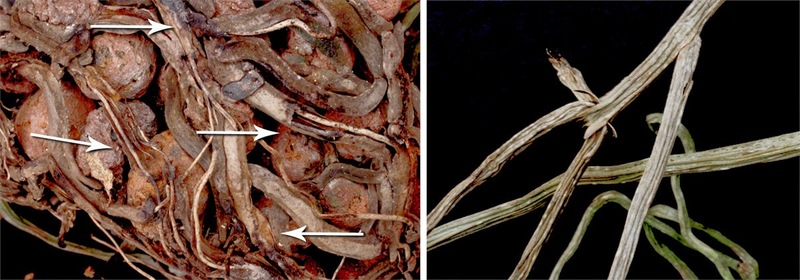One of the common ways of killing your orchids is not watering them properly; watering properly takes some time to learn when you’re a beginning hobbyist (as well as some of us that have the experience to know better). But what may have happened if you are sure that you knew what you were doing?
Whether you had your hand in it or there was another circumstance, we all know orchids die without the right amount of water.
Two issues that have come to my attention via the Angraecums blog may shine some light on the subject. An Angcm. sesquipedale and an Angcm. Crestwood both started dropping their leaves from the bottom of the stem until the leaf drop eventually reached the crown. Both plants were mature specimens producing beautiful flowers on a yearly basis.
Orchids and other types of plants will start to show signs of stress when being dehydrated. Leaves usually show the biggest sign; they begin to wrinkle or shrivel, pseudo bulbs will thin out and not look as plump and stems/canes can begin to bend over and not hold up as they should. These signs point towards lack of moisture. Either not enough water is making it to the root system or there are no longer enough roots to supply the plant with that moisture.
Seeing these signs, many of us will automatically start giving the plant more water. However, what if we see no sign of improvement in a short period of time and the plant continues to deteriorate; let’s assume the root system has failed.
 Signs of severe root rot Shriveled aerial root
Signs of severe root rot Shriveled aerial root
I looked closely at this problem with an Angcm. sesquipedale recently and found that the root system was totally dead. The vellum material that covers the actual root had completely disappeared, what material did exist was barely a shell and much of it was black. This black on the vellum material indicated severe root rot. Somehow, the plant was getting to much water and was constantly wet even though the potting material allowed for fast drainage and the pot itself had plenty of openings for good air movement (which in itself would cause issues if the air around the plant was still). The bottom line is that the roots were always very wet and eventually rotted. Aerial roots were present but not enough of them to salvage the plant. Those roots shriveled and did not supply the plant with the necessary moisture (sort of a catch-22).
The second plant I looked was an Angcm. Crestwood. Leaves were turning yellow and then dropping off starting at the bottom of the stem. The plant had been staked holding it upright; and with the stem as thick as it was, the stake shouldn’t have been needed. The initial problem was that wind had toppled the plant breaking the stem completely through just under the medium in which it was potted. The severed stem prevented the roots from passing moisture up into the plant causing a fast and steady dehydration.
 Last fallen leaves from Angcm. Crestwood Break at bottom of stem
Last fallen leaves from Angcm. Crestwood Break at bottom of stem
Both of the above issues were caused by damage to the root system. By carefully monitoring the watering cycle of the first plant may have prevented the plant from dehydration. Protecting large showy plants such as the Angcm. Crestwood from strong winds would have prevented the plant from being blown over which caused the break in the stem. Understanding how plants eventually die will make us better growers. Growing orchids successfully means learning how to control all of the variables; and issues with watering them is just one small piece of a complex puzzle.
